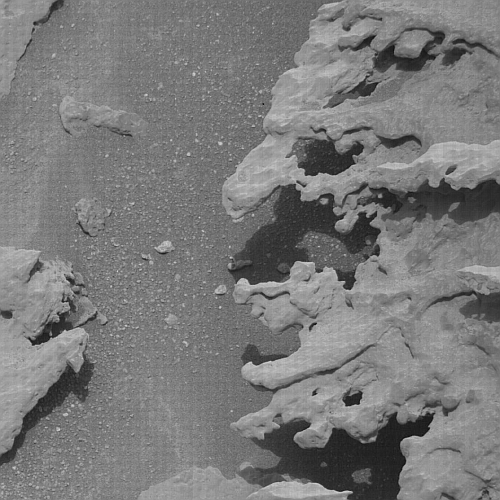The weirdly eroded rocks of Mount Sharp
Cool image time! The picture to the right, cropped, reduced, and enhanced to post here, was taken on November 2, 2022 by one of the high resolution cameras on the Mars rover Curiosity.
There isn’t much to say. This strangely eroded rock appears somewhat typical for many surface rocks in this area in the foothills of Mount Sharp. The erosion is likely from wind, combined with the rock’s low density because of Mars’ one-third Earth gravity. Even so, that wind would have needed many many eons to achieve this erosion, as the atmosphere on Mars is only about 1% as thick as Earth’s.
The lack of data also leaves open the possibility that other as-yet-unknown chemical processes contributed to that erosion.
Note: The grid pattern in the image is an artifact from the camera, and is not an actual feature on the Martian surface.
On Christmas Eve 1968 three Americans became the first humans to visit another world. What they did to celebrate was unexpected and profound, and will be remembered throughout all human history. Genesis: the Story of Apollo 8, Robert Zimmerman's classic history of humanity's first journey to another world, tells that story, and it is now available as both an ebook and an audiobook, both with a foreword by Valerie Anders and a new introduction by Robert Zimmerman.
The print edition can be purchased at Amazon or from any other book seller. If you want an autographed copy the price is $60 for the hardback and $45 for the paperback, plus $8 shipping for each. Go here for purchasing details. The ebook is available everywhere for $5.99 (before discount) at amazon, or direct from my ebook publisher, ebookit. If you buy it from ebookit you don't support the big tech companies and the author gets a bigger cut much sooner.
The audiobook is also available at all these vendors, and is also free with a 30-day trial membership to Audible.
"Not simply about one mission, [Genesis] is also the history of America's quest for the moon... Zimmerman has done a masterful job of tying disparate events together into a solid account of one of America's greatest human triumphs."--San Antonio Express-News
Cool image time! The picture to the right, cropped, reduced, and enhanced to post here, was taken on November 2, 2022 by one of the high resolution cameras on the Mars rover Curiosity.
There isn’t much to say. This strangely eroded rock appears somewhat typical for many surface rocks in this area in the foothills of Mount Sharp. The erosion is likely from wind, combined with the rock’s low density because of Mars’ one-third Earth gravity. Even so, that wind would have needed many many eons to achieve this erosion, as the atmosphere on Mars is only about 1% as thick as Earth’s.
The lack of data also leaves open the possibility that other as-yet-unknown chemical processes contributed to that erosion.
Note: The grid pattern in the image is an artifact from the camera, and is not an actual feature on the Martian surface.
On Christmas Eve 1968 three Americans became the first humans to visit another world. What they did to celebrate was unexpected and profound, and will be remembered throughout all human history. Genesis: the Story of Apollo 8, Robert Zimmerman's classic history of humanity's first journey to another world, tells that story, and it is now available as both an ebook and an audiobook, both with a foreword by Valerie Anders and a new introduction by Robert Zimmerman.
The print edition can be purchased at Amazon or from any other book seller. If you want an autographed copy the price is $60 for the hardback and $45 for the paperback, plus $8 shipping for each. Go here for purchasing details. The ebook is available everywhere for $5.99 (before discount) at amazon, or direct from my ebook publisher, ebookit. If you buy it from ebookit you don't support the big tech companies and the author gets a bigger cut much sooner.
The audiobook is also available at all these vendors, and is also free with a 30-day trial membership to Audible.
"Not simply about one mission, [Genesis] is also the history of America's quest for the moon... Zimmerman has done a masterful job of tying disparate events together into a solid account of one of America's greatest human triumphs."--San Antonio Express-News



For me, the fascinating bit of such features on Mars is not the erosion process itself, but what process left behind these “fossils”
They are blobby, kind of fluid looking… Why are they tougher than the eroded substrate they exist in?
No doubt minds greater than mine are thinking the same, and searching for answers… And hopefully will figure it out in the not too distant future.
Fascinating. What is the scale of the image?
The forms remind me of underwater shapes.
Brad: The forms visible in this image are probably no more than six inches across, though probably half that.